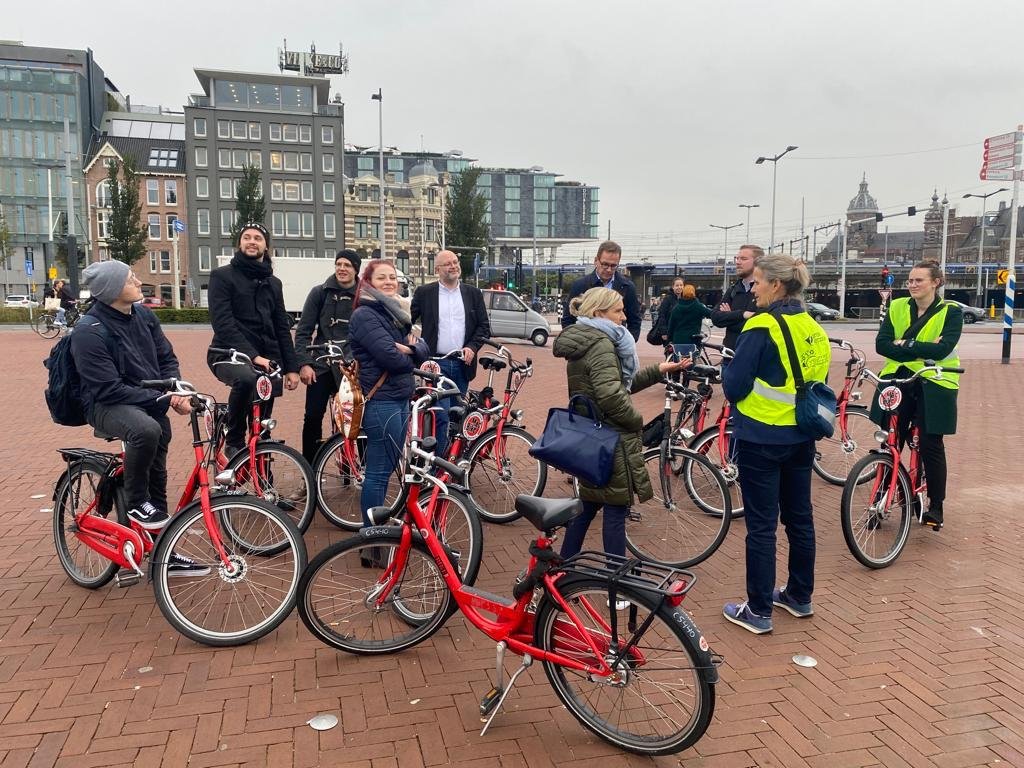2022: Delegations visiting Amsterdam Bike City
Cycling is essential to keep Amsterdam healthy, mobile and sustainable. It may seem that good and safe cycling in Amsterdam is a matter of course, but Amsterdam also had numerous challenges getting to this point. The development of the bicycle city comes with new challenges. Amsterdam Bike City was created to share knowledge and experience about cycling and cycling policy. Delegations from various cities worldwide visit Amsterdam to gain inspiration about cycling and cycling policy. In this article, you can read about the delegations that visited Amsterdam in 2022 and which challenges they wanted to focus on.
May 12, 2022 – Zurich
On May 12th, a delegation from Zurich visited Amsterdam. In addition to the bicycle theme, they also came to learn about recycling, construction in the city, and the reuse of construction materials. Amsterdam Bike City provided a guided tour by bicycle about bicycle facilities and the bicycle-inclusive policy. Among other things, we looked at the distribution of space between cyclists, cars, and pedestrians in different streets, such as the bicycle street in Sarphatistraat, and the organization of bicycle parking in places where space is limited.
May 16, 2022 – Turin and Rome
On May 16th, a large group from Italy traveled to Amsterdam as part of the Handshake project. Handshake is a collaboration of 13 cities in Europe, in which knowledge and experience are exchanged to improve cycling in the city. Amsterdam is an exemplary city for cities such as Rome and Turin.
The group from Italy was therefore broadly interested in acquiring knowledge about different cycling situations and experiencing how cycling in Amsterdam works, and how this came about. During the three-day program, eight bicycle tours were organized, in which the group of about 50 visitors got a good idea of cycling in Amsterdam. During this tour, we looked at bicycle parking examples, urban innovations, the layout of Amsterdam city streets, and intersections where more space has been created for cyclists.
This delegation found “understanding how important it is to cooperate and dialogue among different offices about almost every project” and “that every change takes resistance” especially enlightening.
The nice thing about these visits is that not only do others learn from Amsterdam, but Amsterdam can also learn from its visitors. For example, the delegation from Italy has a lot of data to share about different projects and measures.
May 30, 2022 – Dublin
On May 30th, a group of 14 politicians and civil servants from Dublin came to Amsterdam. There are great opportunities for cycling developments in Dublin: there is attention for cycling from political representatives, there is an active group of cyclists and more and more cycling infrastructure is being built in the city. From this point, policymakers try to promote cycling.
During the first part of the day, the group had a bike tour in which we focused on different types of infrastructure: main roads, bike streets, bike paths, and bike parking. In the second part of the day, there was a workshop on cycling policy, in which we took a closer look at the current situation – the goals, the opportunities, and the challenges for cycling in Dublin. This workshop made it clear that better cycling in itself is not the goal, but that cycling is an instrument to make Dublin safer and more liveable. This conclusion plays a positive role in the – always difficult – discussion about the redistribution of space. It is difficult to claim space for cyclists, while the group of cyclists is not yet very large. Because the goal appears to be broader than just ‘better cycling’, there are more arguments for claiming space for cyclists.
14-10-2022 – Vienna
On October 14th, a delegation from Vienna, consisting of representatives of the Vienna public transport company and officials of the city of Vienna, visited Amsterdam. This group was particularly interested in the subject of ‘bicycle parking’ – in particular the organized parking of bicycles in busy places in the city.
During a cycling tour, we looked at various solutions for bicycle parking in the city center, such as the bicycle parking facilities at the central station (large parts of which are still under construction) and the underground bicycle parking facilities on Beursplein and under the central library. We also looked at what happens on the street above the parking facilities. The purpose of such an underground parking facility is more space for other things. Enforcement is also necessary to prevent bicycles from being parked on the street. You can read more about underground bicycle parking here.
In addition, we looked at simpler solutions on the street, such as bicycle parking bays near shops, bicycle racks on the street to which bicycles can be safely secured, and bicycle parking boats in the Singel. Parking bicycles on the water frees up space on the quay.
In this article, you can read more about bicycle parking in Amsterdam.

19-10-2022 – Dortmund
Dortmund is developing a bicycle network. To learn more about this, a delegation from Dortmund came to Amsterdam in October. This delegation consisted of officials responsible for planning and infrastructure in Dortmund. The group was particularly interested in the development of a bicycle network, the redistribution of space, and the system of plus and main networks.
With presentations about the Amsterdam bicycle network, bicycle developments outside of Amsterdam, and the Amsterdam Autoluw program (the program promoting fewer cars in the city), the visitors were given a wide picture of the development of a bicycle city and the (step-by-step) reduction of cars in the city.
During the tour by bicycle, a good example of reducing cars was shown: theWeesperstraat, which previously consisted of two lanes per direction. One lane was removed to make room for work. This turned out to work fine, so this measure has been retained. Space has been made for cyclists on the freed-up road and pedestrians have more space on the sidewalk.
It was inspiring for us to see that there is a very ambitious project in Dortmund, with strict objectives. These targets are tighter than we are used to in Amsterdam, which is interesting to compare.

25-10-2022 – Sejong City (Korea)
Sejong City is a new city where many government buildings are built. The group of officials visiting from this city asked an interesting question: why ride a bicycle if you are rich enough to drive a car? This is an interesting question, in which the design of the city plays a major role. In Sejong City, there are many wide streets with plenty of room for car traffic. That seems convenient, but it might make driving too easy. In Amsterdam, there are mainly narrow streets, which makes it easier and faster to travel by bicycle than by car. This is healthier for the city and its residents.
The example of car restrictions in Weesperstraat was also shown to the delegation from Sejong. Those present were curious about what residents thought of this. They were surprised that (most) residents welcomed this change. The people of Amsterdam need less noise and pollution in the city, which means there is a great deal of support for fewer cars and better cycling. This is not yet the case in Sejong City. All in all a valuable and educational experience for both Sejong and Amsterdam.
18-11-2022 – Antwerpen
The last delegation of this year came from Antwerp. This was a large and diverse group consisting of activists, representatives of a social organization, shopkeepers, civil servants, administrators and scientists. These people are united in their efforts to improve the Turnhoutsebaan in Antwerp. There is a lot of car traffic on this narrow street, which puts pressure on quality of life and safety. The group came to Amsterdam to gain experience and inspiration about the transformation of city streets.
Developments in Amsterdam city streets have been explained in a presentation. Step by step, space for cars was reduced in Amsterdam, and more space was created for bicycles. This was a positive development for the city, but it has not always been easy to get to this point.
At the beginning of this century, many in Amsterdam still thought that the accessibility of streets for cars would be crucial for, for example, the turnover of entrepreneurs. This idea is still prevalent in Antwerp as well. A conversation with an Amsterdam entrepreneur yielded interesting insights. In recent years, the streets of Amsterdam have become less accessible to cars and, therefore, more accessible to cyclists. This development has been positive for many retailers.
Have you read interesting examples? Are there cycling issues in your city, and would you like to gain inspiration in Amsterdam about tackling these issues? Please contact us at bikecity@amsterdam.nl. We will see if we can arrange a visit.







